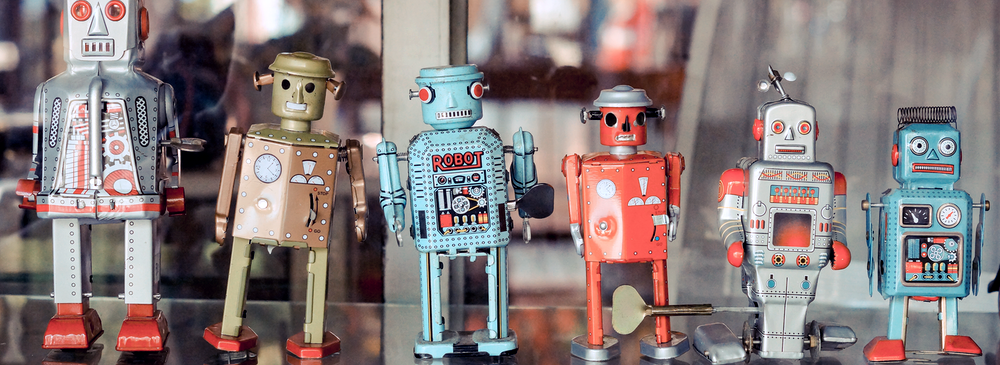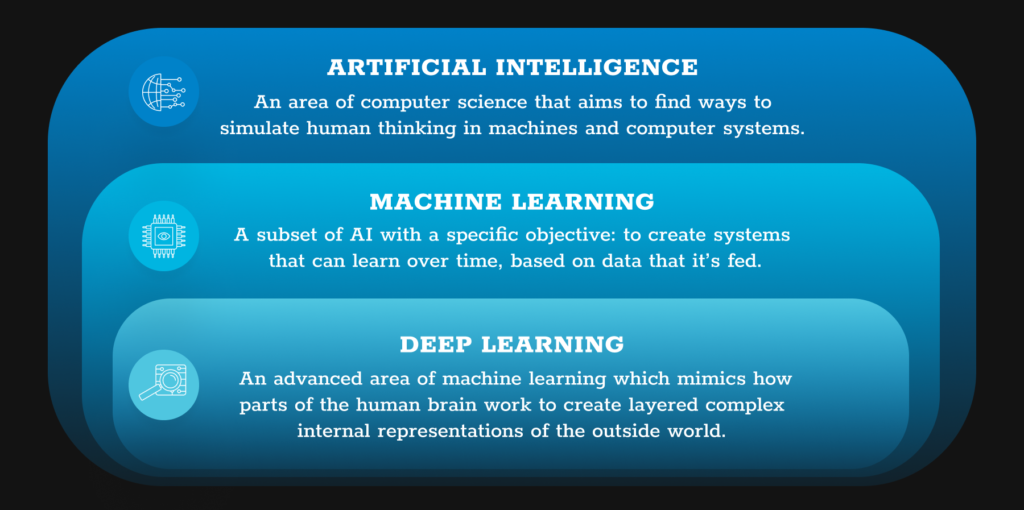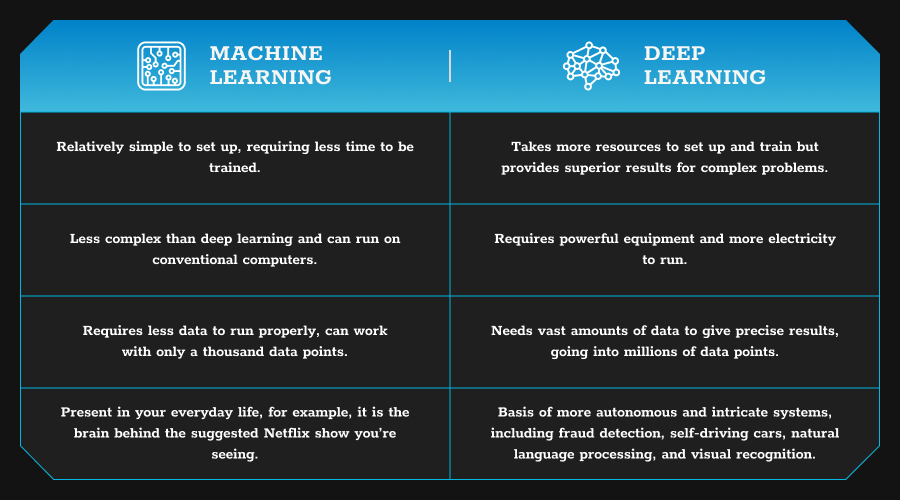
Machine Learning vs Deep Learning: Differences and Similarities

Article updated on: 15 March 2024
Alexa can order groceries or play your favorite music, and Siri can remind you of important meetings and reply to emails. Although they come from different developers, both are digital voice assistants and advanced artificial intelligence (AI) solutions.
They are also clear proof that technology has become an inseparable part of our lives. It continues to evolve, making everyday activities easier, helping us analyze mountains of information, and speeding up lengthy processes.
But to take full advantage of your business data, it’s vital to invest in systems that can help you process it and produce actionable insights. As a result, data-driven companies – which treat data like a strategic asset – are set to dominate the business world in the coming years.
But even though many businesses use AI, machine learning, and deep learning as buzzwords meant to showcase their ingenuity, leaders still struggle to understand what they mean and how they bring tangible benefits to their company and customers.
In this article we’ll cover:
- what is AI
- what is machine learning
- what is deep learning
- differences between machine learning and deep learning
- frequently asked questions on machine learning and deep learning
So let’s jump right in.
What is AI?
Artificial intelligence is an area of computer science that aims to find ways to simulate human thinking in machines and computer systems. The goal is to emulate or even improve the thinking process, giving us access to a new level of technological advancement.
However, the story of AI is not a new one. It began after World War II when the British mathematician Alan Turing posed a seemingly simple question: is it possible for machines to think?
Today, there are four types of artificial intelligence: reactive machines, limited memory, theory of mind, and self-awareness. However, the last two are only theoretical and are (at least for now) limited only to the Hollywood big screen.
But how are AI, machine learning, and deep learning connected, and what are their differences?

What is Machine Learning?
Machine learning is a subset of AI with a specific objective: to create systems that can learn over time, based on data that they’re fed. In most cases, computers receive structured data, then use algorithms to analyze it, and act based on the gathered insights.
The structured data is input in the form of rows and columns, categorized in a way computers can work with it. Moreover, machine learning algorithms can instantly sort and respond to incoming data, without needing additional human assistance.
Therefore, machine learning is mainly based on self-reliance, but some subsets – like supervised and semi-supervised learning – need human intervention. Here, systems require data scientists to feed them with training data and provide an explicit model teaching it to respond to the input and classify it.
Unsupervised learning, on the other hand, uses unlabeled data and has the freedom to identify associations and patterns on its own.
Reinforcement learning is another important area of machine learning, where the system learns based on its own past experiences. It is mainly used for complex tasks with flexible, unpredictable, and large datasets. For instance, this subset of machine learning plays a significant role in robotics.
What is Deep Learning?
Deep learning is an advanced area of machine learning which mimics how parts of the human brain work to create layered complex internal representations of the outside world.
For example, deep learning is the basis of the future driverless car. Since the conditions on the road change constantly, you need an intelligent system to keep up.
To achieve that, data engineers build multi-layered, sophisticated deep neural networks (DNN), allowing data to remain highly connected while passing between neuron-like nodes.
Two types of deep learning algorithms are the most common:
- Convolutional neural networks: These algorithms are designed to work with images. They scan every element on an image, looking for a feature or an object.
- Recurrent neural networks: These algorithms introduce ‘memory’ to machine learning. As a result, the system ‘learns’ based on old decisions and data points, providing more context when evaluating new information.
Differences between Machine Learning and Deep Learning
When talking about the difference between machine learning and deep learning, it’s best to start with this simple statement: all deep learning is machine learning, but not all machine learning is deep learning.
While there are many differences between the two subsets of AI, these are the biggest ones:

Time and Speed
Machine learning systems are relatively simple to set up, requiring less time to be trained. In contrast, deep learning takes significantly more resources to set up and train, but for very complex problems (e.g. video analysis, object recognition) they provide greatly superior results
Hardware Complexity
Machine learning algorithms are less complex than deep learning and can run on conventional computers. On the other hand, deep learning systems require powerful equipment and more electricity to run.
Amount of Data Required
Both machine learning and deep learning systems can make use of structured and unstructured data. However, the difference is in the amount of data that they require to run properly, as deep learning often needs millions of data points whereas machine learning can work with only a thousand.
Application
Even though you might not notice, machine learning is present in your everyday life. For example, it is the brain behind the suggested Netflix show you’re seeing or Facebook recognizing your friends on photos. On the other hand, deep learning is the basis of more autonomous and intricate systems, including fraud detection, self-driving cars, natural language processing, and visual recognition.
Frequently Asked Questions About Machine Learning and Deep Learning
- How are the training processes for machine learning and deep learning different? How does this difference affect their accuracy and efficiency?
As mentioned, machine learning models learn by identifying patterns and often need humans to refine the process. On the other hand, deep learning has many layers of neural networks that help them learn autonomously. This makes these models more efficient when handling large datasets. As a result, deep learning models become more accurate and efficient as the amount of data they process increases, unlike traditional ML models that can reach a plateau in their performance.
- What are some real-world examples of the benefits of deep learning models compared to traditional machine learning?
Deep learning models can identify complex patterns and make more nuanced decisions than traditional models. This means that they are more accurate when it comes to use cases such as predicting changes in price or demand based on market changes, or personalizing recommendations to improve customer experiences based on past behaviors or demographics.
- How do the costs of deep learning and machine learning compare?
The costs of implementing deep learning models are usually higher compared to traditional machine learning. This is because deep learning requires more powerful hardware and larger sets of data. However, the initial investment in deep learning might be offset by its greater efficiency and less need for human oversight in the long run. When deciding, it’s always best to compare the investment to the complexity of the use cases you are focusing on, as that will significantly impact choosing one or the other.
- How can businesses measure the return on investment (ROI) when adopting machine learning or deep learning?
Like with any investment, the key to measuring your ROI is to set clear and measurable goals before starting the project, and then track the progress against this benchmark. Depending on your use cases, you can use different metrics to measure the ROI of machine learning and deep learning projects. These include increases in sales, reduced operational costs, or improvement in customer satisfaction.
Authors and Contributors

Martin Bachler | Chief Technical Officer, NETCONOMY








